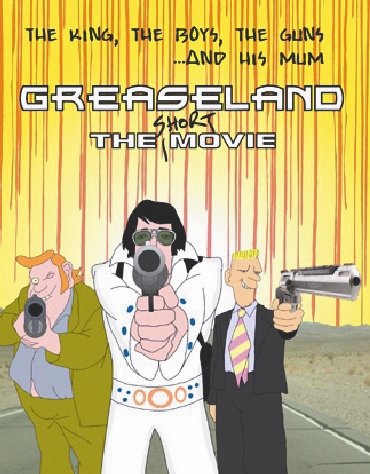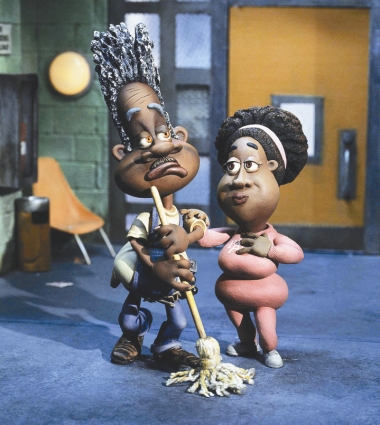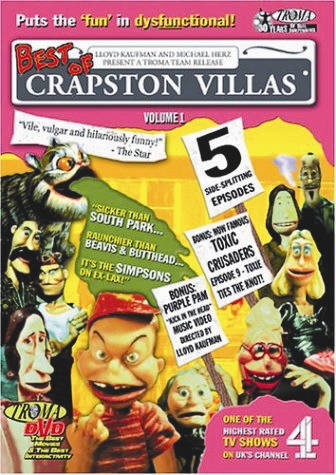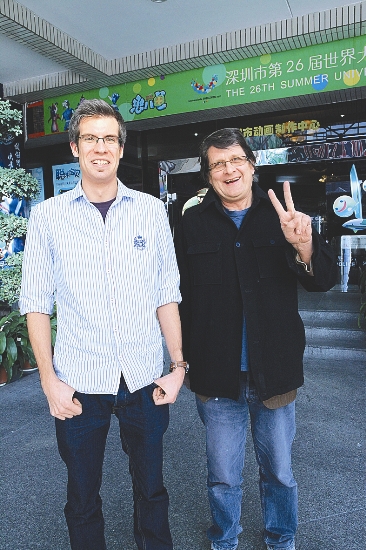|





Cao Zhen
BRITISH animation films, “Wallace and Gromit” and “Chicken Run,” have made quite a mark on the world audience. But Peter Boyd Maclean, one of the directors of Channel 4’s “Crapston Villas” and Fox’s “The PJs,” regrets that most British animations nowadays are co-productions due to the rarity of funds and lack of tax breaks from the conservative British Government.
“In the days of the financial crisis, the government cut everything. Most British animations are co-productions now and we mainly collaborate with Canada, which has financial incentives for animators,” Maclean told the Shenzhen Daily in an exclusive interview.
He had just delivered two addresses at Shenzhen University and the Shenzhen National Cartoon and Animation Industry Base last week, together with budding British animation director, Adam Bailey.
“But I still have an addiction for animation. When it gets into your blood, it stays with you forever,” said Maclean.
Maclean has been in TV for 25 years but before becoming involved in animation, he helped create ground-breaking live action programs including “The Lonely Planet/Globetrekker” hosted by Ian Wright and Justine Shapiro, “Japanorama” (BBC3) hosted by Jonathan Ross, “Mean Machines” (Discovery) and “Bloody Britain” (Discovery).
From 1995 to 1997, Maclean was invited by Spitting Image Productions to direct the animated TV series “Crapston Villas” Season 2 for Channel 4. The comedy satire on inner-city London life features characters made from plasticine and filmed with stop-motion clay animation.
In Maclean’s words, the series was directed at “youngsters who drink a lot on a Friday night.”
“The characters are plagued by all sorts of modern society dilemmas. They have fears, worries and speak foul language,” he says.
Because of extensive content of youth misbehavior, “Crapston Villas” was broadcast late at night but attracted loads of advertisers, says Maclean. Described by the Daily Star as “vile, vulgar and hilariously funny,” and by The Guardian as “of dubious taste,” the show was the talk of the town at that time but was replaced later by a less obviously vulgar U.S. import “South Park.”
“If you use real people to perform the vulgar things in ‘Crapston Villas,’ I’m afraid the audience would be uncomfortable. So animation is a perfect vehicle for me to express my feelings and since then, I’ve been in love with animation,” says Maclean.
Renowned for his strong visual and irreverent style, Maclean was invited by Fox Studios in 1998 to direct “The PJs,” a multimillion-budget stop-motion TV series although at the time, advancements in computer animation had put stop-motion in the shade.
“In the United States, they have big budgets and do everything on a big scale, so they have a different sensibility,” says Maclean, who feels sorry that less than 5 percent of animations shown in his country are purely British-made.
Voiced by Eddie Murphy, “The PJs” portrays life in an urban Detroit public housing project. Although it won three Emmy Awards, some social activists, including director Spike Lee, accused the show of depicting negative racial stereotypes.
“All the remarks, and even critics, are good for animators because your work gets attentions and you know how to make your next work acceptable,” says Maclean.
He believes that although stop-motion animation has rarely been seen in the TV industry because the costs were higher than computer 2D productions, there has been an increasing number of stop-motion films in Hollywood, such as “Corpse Bride” and “Fantastic Mr. Fox.”
“An animator can only produce an eight-second clip each day but those shooting real-person videos can produce 20 minutes a day. For animators, you need not only funds but also patience and devotion,” said Maclean.
Bailey, 26, agrees that patience matters for an animator but for a young director just out of university, persistence counts more.
“Every morning I wake up, I’m thinking of writing e-mails, making phone calls to my clients or doing my animations,” says Bailey, whose work has been shown at over 50 events around the world including screenings, exhibitions, installations, and showings with a live music ensemble.
“The reason my works are shown to the public is because of my endless contact with people. For me, animation is everything so I never get tired of contacting people, sending out business cards, attending numerous events. I might get only one response after sending 300 e-mails but that one counts,” he said.
After graduating from the University for the Creative Arts at Farnham in 2007, Bailey spent two years working in Sofia, Bulgaria, for clients that included Comedy Central, NBC and FX on multiple TV shows before setting up his own studio, Adoodlebailey, in London and working for multiple European and U.S. clients.
As one of a younger generation, he expects the future of animation to be realized in a more diversified way. “With the Internet a part of our lives, animations can be shared on various platforms, such as iPhone, video-sharing or social networking sites. Cultural boundaries will finally disappear.”
|

